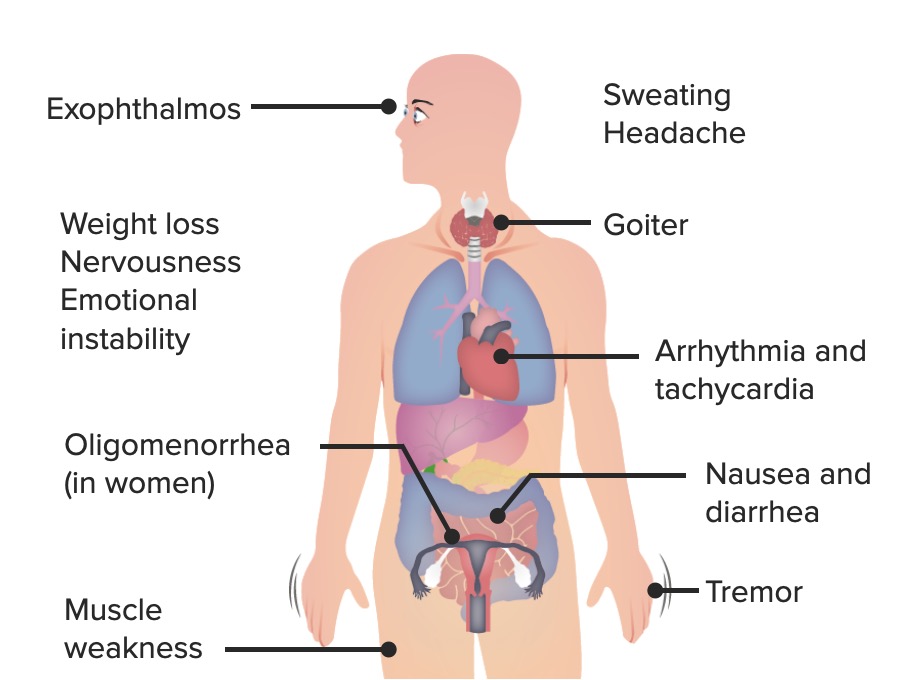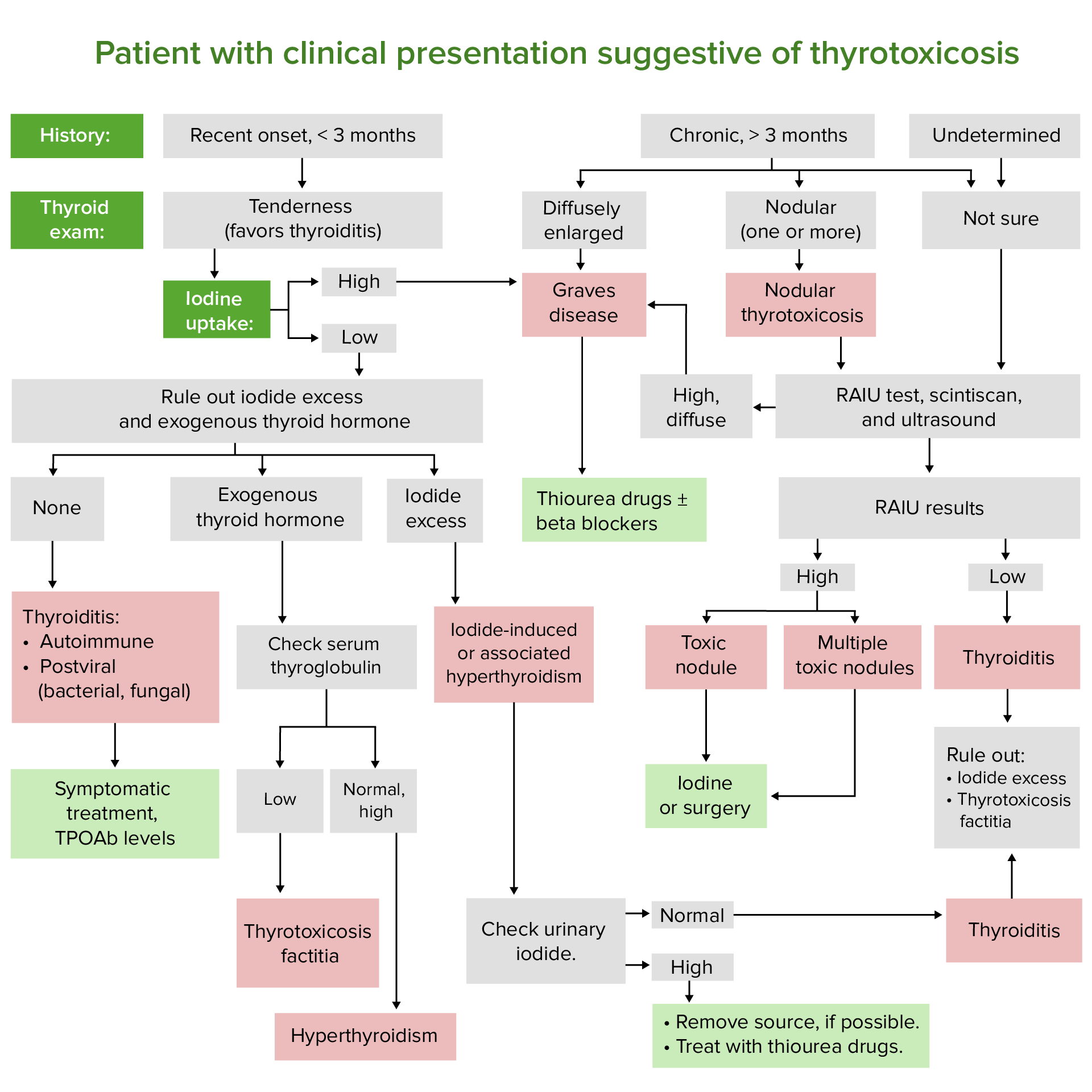Playlist
Show Playlist
Hide Playlist
Euthyroid Hyperthyroxinemia – Euthyroid Conditions
-
Slides EuthyroidConditionsLaboratoryInvestigations EndocrinePathology.pdf
-
Download Lecture Overview
00:01 A topic that you want to be extremely comfortable with it's called euthyroid conditions and laboratory investigation. 00:08 As simple as this may seem, there are certain things that you want to take out of this section that is going to help you differentiate one type of thyroid pathology from the other. 00:18 Do not underestimate what I have to tell you now. 00:23 This brings us to our first discussion of euthyroid break it up Eu prefix normal thyroid. 00:32 The pathology is going to lie within hyperthoraxinemia. 00:38 Break this up. 00:39 When you say thyroxinemia referring to T4 in your blood In this case we have hyper. 00:47 So how could you possibly have a normal thyroid state and be hyperthyroxinemic? The discussion now brings us back to our physiologic point of view of thyroid-binding globulin. 01:02 Remember the definition of total. 01:04 Total is bound plus free. 01:08 What is the component that makes up majority of the total? It is the bound. 01:14 So therefore, euthyroid hyperthyroxinemia due to, in general, increased binding protein. 01:23 What is this specifically for thyroid hormone? Thyroid-binding globulin. 01:26 Coming from where? The liver. 01:28 Your emphasis and focus should be on? Well, what is then causing liver to increase? Is thyroid-binding globulin. 01:38 Before we get there, Abnormalities. 01:42 T4 Binding Majority of your T4 is bound by thyroid-binding globulin, transthyretin, albumin, the most common cause MCC of hyperthyroxinemia would be TBG excess. 01:56 What was that going to do to your total? Total what? Total T4. Increases it. 02:02 Why? What then binds to my TBG? T4 does. 02:07 I'll show you this. 02:10 Remember, the majority of your thyroid hormone being released into circulation is T4. 02:15 It has to be bound to TBG. 02:18 Whenever TBG is found to be an excess, you would then expect there to be a total in T4. 02:25 Hence hyperthyroxinemia. 02:29 What about that T3? Well, as far as the normal functioning, or the functioning of the body, it is within normal state euthyroid. 02:39 It could be hereditary. 02:44 Estrogen. 02:46 Whenever you find a patient in a hyperestrogenic state, such as pregnancy, or contraceptive pills that may contain estrogen. 02:57 Estrogen works in liver to increase glycosylation of TBG. 03:01 When you increase your TBG, you're going to then decrease to clearance. 03:07 So therefore, with all this TBG that resides within your circulation, guess what it is going to bind to... 03:14 T4. 03:16 So you increase in the bound faction of yourself thyroid hormone. 03:22 Thus, what are you doing to total? You're increasing it. 03:26 Keep him bound and total separate. 03:29 resulting in hyperthyroxinemia. 03:32 What other conditions might there result in increase or excess TBG? Hepatitis. 03:41 Drugs such as methadone, tamoxifen, a porphyria pathology in biochemistry that you've heard it called Acute Intermittent Porphyria, oftentimes, you'll find euthyroid hyperthyroxinemia, reduced thyroxine deiodination, such amiodarone or propanolol could all result in euthyroid hyperthyroxinemia. 04:04 What do you mean by deiodination that conversion of T4 to T3 is not taking place, effectively? Want to show you a picture here of what's important to you clinically? You're going to use this picture so that you can then first understand normal then understand what's happening in a state here of euthyroid hyperthyroxinemia And truly, when you read a stem of a question, or you're dealing with the patient, and you're having discussion with your attending, you know what he or she is referring to. 04:43 Let's begin on the left here where it's perfectly normal. 04:48 The huge blocks that you're seeing here, the blocks is your TBG Thyroid-binding globulin. 04:58 Coming from where? The liver. 05:00 What is that TBG going to bind to? T4. 05:06 Stop. 05:07 Now you're left for T3. 05:10 You're going to be using clinically, or interpreting what's known as a Thyroid Hormone Binding Resin. 05:18 You want to keep your resin which is what you're going to interpret clinically, separate from your TBG, which are these blocks that you're seeing bound to T4. 05:32 As long as you're within normal state, and you have adequate and normal amounts of TBG, Then the resin is going to bind exactly as to what it needs to with T3. 05:46 Let us now move on to the right side of this illustration. 05:52 And the right half is then showing you euthyroid hyperthyroxinemia. 05:57 What is the difference between the pathology on the right versus the physiology on the left? You'll notice, please, that you have increased number of these blocks. 06:09 How did this occur? Oh, maybe it was estrogen. 06:12 Or a patient that was in a hyperestrogenism state. 06:18 When you increase to TBG, you're going to bind more T4 when you bind more T4 what fraction of your total have you increased? The bound. 06:29 What happens to total? It increases it. 06:32 Therefore what do you call this? Hyperthyroxinemia. 06:36 But why is it euthyroid? You're still euthyroid because even though you're robbing your T4 out of circulation, your thyroid gland and anterior pituitary the axis is going to respond accordingly to start increasing thyroid hormone production to bring it back to normal. 06:58 What do I mean by that? What is the active form of most hormones? Free. 07:05 Free thyroid hormone, free calcium, free cortisone. 07:11 So when you rob your free faction, this is then interpreted as being hypo, your feedback mechanism in your excess is immediately going to respond so that it can replenish the free your state of euthyroid. 07:28 That picture on the right is probably one of the most important pictures that you want to be able to interpret in pregnancy. 07:36 In pregnancy, with the increase estrogen, you're going to increase your TBG you're going to then bind and remove the free faction of your T4 out of circulation. 07:47 Are you picturing that? And thus, immediately during pregnancy, the mother is then going to start increasing her production of thyroid hormone so that you bring or she brings the thyroid hormone back free faction back up to normal. 08:03 And of course that is absolutely critical to occur or otherwise, the fetus is going to feel the effects of hypothyroidism. 08:10 and you cannot have that. 08:14 The last little point that we'll make here, I want you to focus upon the resin there. 08:18 And at the end of the section, I'm going to walk you through a table where that resin which has been binding to T3 will then tell you what's actually happening in a patient that is differentials for euthyroid. 08:34 Understand these two pictures for now, I'm gonna build, and build, and build upon these until we finally come to a table where I'll summarize everything for you clearly.
About the Lecture
The lecture Euthyroid Hyperthyroxinemia – Euthyroid Conditions by Carlo Raj, MD is from the course Thyroid Gland Disorders.
Included Quiz Questions
What causes euthyroid hyperthyroxinemia?
- Increased binding proteins
- Increased T4
- Increased conversion of T3 to T4, leading to decreased T3
- Decreased estrogen leads to decreased binding proteins
- Decreased albumin leads to increased TBG binding to T4
What increases glycosylation of thyroid-binding globulin (TBG), leading to decreased clearance?
- An increased concentration of estrogen
- Hepatitis
- Acute intermittent porphyria
- Amiodarone excess
- Methadone
Which medication does NOT increase the levels of thyroid-binding globulin (TBG)?
- Progesterone-only contraceptives
- Methadone
- Amiodarone
- Propanolol
- Tamoxifen
What is the pathophysiology of euthyroid hyperthyroxinemia in a pregnant woman?
- A high level of estrogen increases the level of thyroid-binding globulin (TBG), decreases free T4, and increases T4 production.
- Increased estrogen increases the level of TBG, decreasing bound T3.
- Delivery of the thyroid hormone to the fetus decreases the available thyroid hormone for the mother, leading to increased production.
- Increased TBG due to decreased bound T4 leads to a spike in estrogen until TBG levels even out.
- Decreased TBG due to increased delivery of T4 to the fetus leads to increased production of TBG.
What percentage of T4 is normally bound to thyroid-binding globulin (TBG) in the bloodstream?
- 70%
- 16%
- 99%
- 15%
- 80%
Customer reviews
5,0 of 5 stars
| 5 Stars |
|
5 |
| 4 Stars |
|
0 |
| 3 Stars |
|
0 |
| 2 Stars |
|
0 |
| 1 Star |
|
0 |





